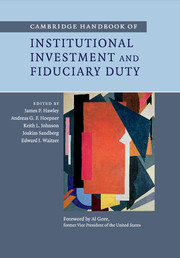Book contents
- Frontmatter
- Contents
- List of figures
- List of tables
- List of contributors
- Foreword
- 1 Introduction
- Part I Fiduciary duty: a global outlook
- Part II Fiduciary duty and the landscape of institutional investment
- Part III Challenging conventional wisdom on fiduciary duty
- Part IV Towards a broader interpretation of fiduciary duty
- Part V Beneficiaries’ roles and viewpoints
- 26 The voice of the beneficiary
- 27 Understanding the attitudes of beneficiaries: should fiduciary duty include social, ethical and environmental concerns?
- 28 Operationalizing socially responsible investment: a nonfinancial fiduciary duty problem
- 29 The preferences of beneficiaries: what can we learn from research on retail investors?
- Part VI Fiduciary duty and governance
- Index
- References
29 - The preferences of beneficiaries: what can we learn from research on retail investors?
Published online by Cambridge University Press: 05 April 2014
- Frontmatter
- Contents
- List of figures
- List of tables
- List of contributors
- Foreword
- 1 Introduction
- Part I Fiduciary duty: a global outlook
- Part II Fiduciary duty and the landscape of institutional investment
- Part III Challenging conventional wisdom on fiduciary duty
- Part IV Towards a broader interpretation of fiduciary duty
- Part V Beneficiaries’ roles and viewpoints
- 26 The voice of the beneficiary
- 27 Understanding the attitudes of beneficiaries: should fiduciary duty include social, ethical and environmental concerns?
- 28 Operationalizing socially responsible investment: a nonfinancial fiduciary duty problem
- 29 The preferences of beneficiaries: what can we learn from research on retail investors?
- Part VI Fiduciary duty and governance
- Index
- References
Summary
Introduction
During the last few years increasing attention has been given to the integration of environmental, social and governance (ESG) issues into various parts of the investment industry. While the fact that ESG issues often are debated, and that socially responsible investment (SRI) is a common phenomenon in the investment context, may come as a surprise to people who associate the finance industry with strictly utilitarian financial transactions, it is not particularly surprising given the amount and relevance of the environmental and social problems facing mankind. As a consequence of issues such as global warming, abuse of natural resources and global inequality, increasing corporate responsibility is now often demanded from several actors in society such as citizens, non-governmental organizations and consumers.
Even though ESG issues are becoming incorporated in both the institutional and retail investment sector, so far it seems like the institutional sector is leading the way. In Europe, for example, as much as 92 percent of the ESG-profiled assets under management are categorized as institutional (Eurosif 2010). Despite this positive development, however, the fact is that actors in the institutional investment context face specific obstacles for ESG integration that is not present in the retail context. Perhaps the most relevant of these obstacles, and the main topic of this book, is captured by the term fiduciary duty. Although the full meaning of this concept is perhaps explained better by legal scholars represented in this volume and elsewhere in the literature, a basic illustration of the impact of the concept for the purpose of this chapter is that while retail investors are free to invest their money in the manner they best see fit, institutional investors such as large pension funds have fiduciary duties toward their beneficiaries that require them to manage their investments in the best interest of the final recipients/owners of the underlying money (e.g., Sandberg 2011; Stabile and Zanglein 2007).
- Type
- Chapter
- Information
- Publisher: Cambridge University PressPrint publication year: 2014
References
- 1
- Cited by



